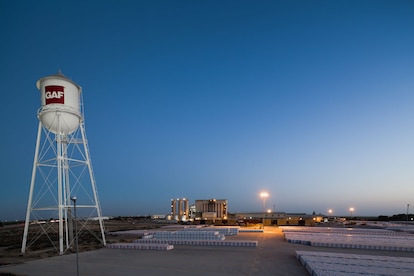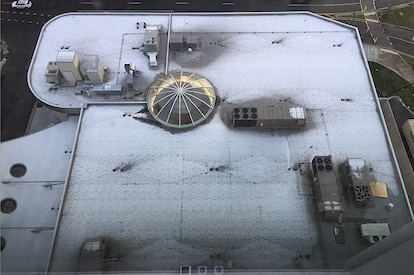If photovoltaic systems (solar arrays) were installed on all the commercial buildings in the US with roofs over 5,000 sq. ft., they are estimated to provide enough energy to power nearly 60% of the total commercial electricity demand. Commercial rooftops are an appealing option as a platform for installing solar arrays to support energy conservation and generation, as well as corporate and community energy initiatives. However, it is important to remember that the roof's primary function is to protect the building and its contents from the elements.
When considering rooftop solar, the roof system should be designed to have an equivalent or longer lifespan than that of the solar arrays. Whether it's a new roof with solar arrays or will have solar arrays installed in the near future, or it's an existing roof that will receive solar, there are many important considerations for roof system design and panel layout.
Roof System Durability
Solar arrays have a useful economic life of up to 25+ years. For commercial rooftop solar, it is often cost-prohibitive to remove the solar arrays, install a new roof and reinstall the solar arrays. Therefore, the best time to install a rooftop solar system is right after a new roof installation or right after a building is newly constructed. The key issue here is that the roof system should have an expected useful life that matches or exceeds the expected economic life of the solar array. To specify a roof system that is as durable as the solar array, designers should consider the following:
- Adhered roof membranes with higher heat resistance and greater mil thickness;
- Incorporation of a cover board;
- Use of high compressive strength rigid insulation; and
- Roof system warranty or guarantee that exceeds the life expectancy of the solar arrays
Roof Membranes
By their nature, reflective roof membranes are beneficial in reducing heat build-up around solar arrays as the temperature of a solar panel can significantly impact how much electricity the panel produces. As panels get hotter, they produce less power. We estimate the efficiency of a solar panel to be up to 13% higher when installed over a highly reflective membrane compared to a dark membrane with low reflectance. Also, the use of bifacial solar panels over reflective roof membranes can increase the efficiency by 20-35%, as they take advantage of the reflected light.
The benefits of specifying a roof membrane that offers enhanced protection against the effects of UV radiation and high service temperatures, and can maintain high reflectance over a long period of time, makes sense when working with rooftop solar. Therefore, regardless of the type of solar installation, the National Roofing Contractors Association (NRCA) recommends the use of a roof membrane that provides enhanced protection against the effects of UV radiation and high service temperatures – for example, GAF's EverGuard Extreme® TPO – to help ensure that the roof life expectancy will match that of the solar arrays.

Example of a highly reflective roof membrane (installed on the lower roof) that maintains its reflectivity as it ages.
Designers and owners may also want to consider an increased roof membrane thickness to match the service life of the solar arrays. Using wider rolls will minimize the number of seams and reduce the potential for seams to be obscured below solar arrays.
Membrane Attachment
The membrane attachment method should be carefully considered. Adhering the membrane will avoid the normal billowing of mechanically fastened single ply membranes, which could cause ballasted systems to shift and result in localized abrasion of the membrane. The use of a protection or separation sheet installed between ballasted supports and the membrane, extending beyond the contact surface area on all sides, can protect the membrane from abrasion and may be required for warranty or guarantee coverage. The protection sheet should be secured to the roof membrane, not to the bottom of the racking system.
Ballasted systems inadvertently placed directly over fasteners may cut or puncture the membrane as the solar array shifts during strong wind events. Burying fasteners in the roof system will minimize the potential of damage (photo) to the roof membrane, as well as enhance thermal performance of the roof system. This reinforces the use of adhered membranes as well as an adhered top layer of insulation and cover board.
Adhered arrays attached to a mechanically attached or induction welded roof system will billow and flutter with the roof membrane. Over time, this could create additional stress on the solar arrays and their connections, and may compromise the solar and roof system performance. Therefore, an adhered roof membrane will contribute to a roof system lifespan that will better match that of the solar arrays, and help enhance the performance of both. Of course, it's necessary to verify material compatibility, long-term durability and heat aging capabilities of the adhesive to the roof membrane and solar arrays, as well as compliance with local code and uplift resistance requirements.
For attached or penetrating systems (i.e. non-ballasted), mechanically attached membranes could be more acceptable than with ballasted systems. Attached arrays do not move and the array attachment points might act as additional anchors for the membrane.
Cover Boards and Insulation
Roof durability is system dependent so we must look beyond the membrane and consider the entire roof assembly. Rooftops with solar arrays are burdened with more trades and increased foot traffic on the roof, and therefore, are more susceptible to degradation and potential leak sources. An easy starting point is to protect high traffic areas with walkway pads. The addition of a hard cover board such as HD polyiso board will also enhance system protection and extend the life expectancy of the roof.
In addition to increased foot traffic, concentrated loads from ballasted systems can exceed the compressive strength of the roof system's membrane and insulation. Specifying a rigid insulation board with high compressive strength, such as a Grade 3 polyiso, will distribute loads and help prevent crushing that may occur with lower compressive strength materials.
Installation
As the cost to install solar arrays is significant, performing an integrity test of the roof membrane prior to installing the solar overburden is a worthwhile investment of time and resources. Designers must understand that with the installation of rooftop solar, the roof system becomes a permanent platform for the continuous operation, service, and maintenance of the arrays. As many solar designers are not intimately familiar with best roofing practices, it is helpful to specify solar layout requirements for rooftop access that align with not only code requirements (i.e., International Fire Code, (IFC) and National Electric Code (NFPA 70)), but with best practices for roof maintenance and safety of rooftop workers. This can include requirements such as prohibiting solar arrays from crossing expansion joints, and setting solar arrays and rack heights such that field seams, drains, and penetrations are accessible for emergency responders and maintenance workers.
Designers and owners also have the opportunity to specify the type of solar attachment, which includes attached, ballasted, or adhered. Each option will impact decisions for the roof system design so project teams should take a holistic approach to any value engineering discussions regarding the roof and solar arrays.
The importance of the electrical and solar contractors collaborating in concert with roofing contractors and design professionals cannot be overstated. Qualified roof professionals must be integrally involved through the design process and inspection (and repair as needed) of the roof after solar installation. Specifying this as a requirement will ensure the roof contractor is engaged throughout the entire process, leaving your roof in the proper condition to protect what matters most.
Solar Array Attachment
Designers have many choices when it comes to solar array attachment and not all systems are considered equal. The NRCA recommends the use of attached or penetrating systems, mounting systems that are attached through the roof to the structure. Penetrations and flashings must be well detailed and coordinated with the roofing contractor, solar contractor, and electrician. These details are critical to the success of the installation and must be designed to align with the life expectancy of the solar array and roof system.

Attached Solar

Ballasted Solar

Adhered Solar
While ballasted systems are cost effective and easy to install, they can add up to 5 pounds per square foot to the roof. While this loading can be incorporated into the structural design for new construction, it may exceed the capacity of an existing building. Additionally, the concentrated loading of ballasted systems can exceed the compressive strength of the roof insulation. Therefore, the use of a higher compressive strength insulation such as Grade 3 polyiso, should be strongly considered. Better yet, specify a cover board such as HD polyiso for added protection.
Ballasted systems can shift and flutter during high winds and seismic activity. This can result in surface abrasion of the roof membrane which can be "detrimental to satisfactory long-term roof system performance", according to the NRCA. If the project team accepts the risks associated with ballasted systems, a protection or separation sheet should be installed between the ballast supports and the membrane, and should be secured to the roof membrane, not the ballast supports.
Ballasted trays can block or inhibit drainage, which can result in ponding water on the roof membrane. This can undermine the performance and service life of the roof system. Given all the performance challenges with ballasted systems, "NRCA is of the opinion ballasted rack systems do not satisfy the equivalent service life criteria necessary for successful roof system performance throughout the useful life of rooftop-mounted PV systems." However, as ballasted systems are often used, it is important to understand potential issues and use an appropriate design approach with your roof system so the lifespan of the roof can exceed that of the solar arrays.
Another attachment option for solar arrays includes adhered thin-film panels which are adhesively applied directly to the roof membrane. The low profile application makes this system attractive to many designers. Documented compatibility between the roof membrane and the adhesive is critical. Of utmost concern is the potential for adhered solar panels to detach over time as the adhesive ages, and experiences elevated temperatures and repetitive wind uplift forces.
As previously discussed, adhered solar arrays require an adhered roof membrane. And given the increased heat load on the roof system with adhered arrays, a roof membrane with enhanced heat aging properties is even more critical.
Solar Array Layout
The logic behind the layout of solar arrays applies to all attachment options. Solar arrays are usually oriented and laid out for maximum solar energy collection. This includes keeping panels back from walls or equipment that provides shading and away from hot air exhaust that will impact efficiency. Designers should also consider the appropriateness of solar arrays installed in high-wind zones, such as corners and perimeters, to avoid potential uplift failures of the solar arrays or the roof system. Arrays should also be configured in such a way to avoid additional snow accumulation.
The layout of solar arrays should also address access for solar installation, solar array and roof maintenance, and fire safety. Safe access of the solar contractors and electricians during installation, as well as service and maintenance over the service life of the solar arrays, must be accounted for in the design. This may include davits or other tie-off points, perimeter access, and consideration to proximity of overhead power lines. The NRCA Guidelines conveniently summarize the requirements from the International Fire Code (IFC) and National Electric Code (NFPA 70). Generally, they require a 4-foot perimeter around roof edges, hatches and a pathway between the two, as well as a pathway along both centerline axes. They also recommend a 4-foot wide pathway to skylights, ventilation hatches and roof stacks for future serviceability. Best practices for fire safety include 8-foot wide pathways for smoke ventilation between panel arrays, and getting approval from the local fire chief.

Rooftop solar layout guidelines published in NRCA Guidelines.
Roof system maintenance is also an important consideration for solar array layout. It is important to align solar arrays and set rack heights such that there is enough clearance to service the roof membrane, especially drains and penetrations. Providing additional space between the arrays and the roof membrane also increases ventilation and reduces heat build-up, which results in more efficient panels. Generally, the most efficient solar arrays are installed in conjunction with vegetative roofs, as they provide a better climate and temperature for solar panels to function, which improves electricity production. The relatively small payback period and the environmental benefits of combining these two sustainable approaches can balance out the initial investment.
Solar Roof System Design Summary
Clearly, there is a lot to consider when adding solar arrays to the roof. The good news is that as rooftop solar becomes more popular, there are more resources available to designers, owners and contractors to help design, install, and maintain a durable roof system that can match or outlast the service life of solar arrays. In summary, best practices for roof system design when considering solar include:
- Roof system warranty or guarantee that aligns with or exceeds the life expectancy of the solar array
- Adhered reflective roof membranes with greater mil thickness that provide enhanced protection against the effects of UV radiation and high service temperatures, such as GAF's EverGuard Extreme® TPO
- Adhered high-compressive strength cover board directly beneath the roof membrane
- High compressive strength insulation for ballasted systems (minimum 2 layers staggered and offset)
- Walk pads for high traffic areas
- Protection or separation sheet adhered to the membrane for ballasted systems
- Integrity testing of the roof membrane prior to installing solar overburden
- Solar layout requirements that align with best practices for roof maintenance
- Layout solar arrays to maximize solar energy collection while avoiding high wind uplift areas and additional snow accumulation
- Provide perimeter and maintenance access for roof and solar array maintenance, as well as fire safety and smoke ventilation
- Set racking systems such that they don't cross roof expansion joints or block drainage
- Set solar arrays and rack heights such that drains and penetrations are accessible for maintenance
- Engage the roof contractor to inspect (and repair as needed) the roof membrane after solar array installation
Additional resources available to designers, owners, and contractors alike include the NRCA Guidelines for Roof-Mounted Photovoltaic System Installation, Single Ply Roofing Institute (SPRI) Bulletin on PV Ready Roof Systems, and the Structural Engineering Association (SEAOC) PV manuals for Structural Seismic Requirements and Wind Design.

For more information on roof design considerations when incorporating solar, register for the Continuing Education Center webinar, Commercial Rooftop Solar: Maximizing a Stellar Opportunity, sponsored by GAF and presented by Jennifer Keegan and Thomas J. Taylor.










